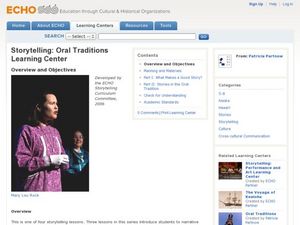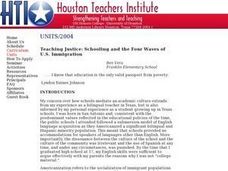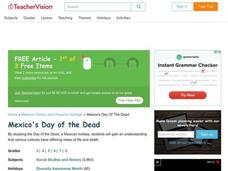Curated OER
Storytelling: Oral Traditions Learning Center
Students explore the oral traditions. In this storytelling lesson, students compare and contrast stories from the cultural traditions of Alaska and Hawaii.
Curated OER
Let's Get Along
Students examine the book Smoky Night. In this cultural lesson, students read the text and discuss why it's important to get along with others. Students complete a Venn diagram to compare and contrast themselves with a peer.
Curated OER
Viewing Bacteria
Have you ever wanted to know the true structure of E.coli? Does the thought of peering into its "small world" sound exciting? Here is a lesson that allows pupils the ability to do just that. Blossoming microbiologists use microscopes to...
Stanford University
Mexican American Rights
What's the best way to date a primary source? A thought-provoking assessment uses written responses to test learners' knowledge of primary source analysis. High school scholars compare text excerpts to determine which documents were...
Folger Shakespeare Library
Essential Everyday Bravery
Shakespeare's plays may be old, but they still have relevant lessons for today's world! A collection of lesson plans uses examples from The Merchant of Venice and District Merchants to teach about bravery. In addition to learning...
Curated OER
Comparing Works By The Same Author: Venn Diagram
A Venn diagram is a great tool. Middle schoolers research specific authors from different time periods, cultures, and genres. In groups, they create a Venn Diagram in order to compare and contrast two pieces of literature by the same...
Curated OER
Belief Systems Along the Silk Roads
Learners examine cultural diffusion. In this Silk Road lesson, young scholars research primary sources to compare and contrast the religious beliefs encountered and shared by those who traded along the Silk Road route.
Curated OER
Teaching Justice: Schooling and the Four Waves of U.S. Immigration
U.S. immigration is the focus of a unit on social justice. Over the course of a school year, young historians read a variety of texts to learn about four waves of immigration that have occurred over time in the U.S. An emphasis on...
Curated OER
Forming Connections Across Generations and Cultures
Students explore contemporary Indian literature. They compare and contrast intergenerational conflict in different cultures. Students explain and clarify their views on marriage and traditions.
Have Fun Teaching
Compare and Contrast Greek Myths (4)
How are Icarus and Prometheus similar? How are they different? Compare any two Greek myths with a graphic organizer, which provides space for kids to fill in the ways that the myths are like and unlike each other.
Maryland Department of Education
The Concept of Diversity in World Literature Lesson 1: Unit Introduction
To launch a unit study of the concept of diversity in World Literature, class members compare Chinua Achebe's essay, "An Image of Africa: Racism in Conrad's Heart of Darkness" and Richard Rodriguez's essay, "The Chinese in All of Us: A...
Maryland Department of Education
The Concept of Diversity in World Literature Lesson 4: Proverbs
"Eneke the bird says since men have learnt to shoot without missing, he has learnt to fly without perching." As part of their study of Things Fall Apart, class members read Paul Hernadi and Francis Steen's essay, "The Tropical Landscapes...
Maryland Department of Education
The Concept of Diversity in World Literature Lesson 5: The Tragic Hero
Should identifying a tragic hero be based on a universal definition or a definition based on the morals and values of a specific culture? As part of a study of Things Fall Apart, class members read Sylvia Plath's "Colossus" and then...
Curated OER
Identifying the Social and Cultural Contexts of a Time Period-The Journey of the Jewish Americans
Pupils discuss the experience of 19th century Jewish American immigrants. In this US history lesson plan, students research the cultural, social, and economic experience of Jews who immigrated to the United States. Pupils view a video...
Curated OER
Teaching Responsibility to Children in Different Cultures through Film and Literature Stories
Students review the notes they took for "The Little Prince". After identifying the instances of responsibility in the text, they discuss them with others in English. As a class, they watch parts of "Children of Heaven" and write down...
Maryland Department of Education
Our Children Can Soar
Amazing efforts of African American leaders are celebrated in a lesson on civil participation. The engaging resource focuses on primary and secondary sources to analyze the impact of African American leaders such as Ella Fitzgerald....
Mary Pope Osborne, Classroom Adventures Program
Mummies in the Morning Egyptian pyramids, hieroglyphics
Visit the Magic Treehouse and take your class on a trip through time with a reading of the children's book Mummies in the Morning. Using the story to spark an investigation into Egyptian culture, this literature unit engages...
National Endowment for the Humanities
Hamlet and the Elizabethan Revenge Ethic in Text and Film
Young scholars research the social context of Elizabethan England for Shakespeare's "Hamlet". They identify cultural influences on the play focusing on the theme of revenge and then analyze and compare film interpretations of the play.
Smithsonian Institution
A New America: The Hart-Celler Immigration Act of 1965
Many dream of coming to America, but few may enter. The lesson explores the Hart-Celler Immigration Act of 1965 and how it changed immigration policies in the United States. Academics learn how immigration quotas impacted Western Europe...
Curated OER
Compare and Contrast Versions of a Story
Compare and contrast reading passages with the ever favorite story of Cinderella. The versions in focus include an Italian version and a Native American story followed by three questions designed to share similarities and differences, as...
Curated OER
Music in Other Cultures
Pupils examine the musical concepts of timbre, melody, and rhythm. They listen to and identify characteristics of music from other cultures.
Curated OER
Immigration Unit
Third graders develop an appreciate for the various cultures that are present in their local community. Through reading and research, they explain how various culture came to live in their area. At the conclusion of the unit, 3rd...
Curated OER
United States-Japan History
Students compare the histories of Japan and the United States by creating horizontal time lines of the two countries. They conduct research via the internet and available text books to complete their time line. The class discusses the...
Curated OER
Mexico's Day of the Dead
Students explore global culture by researching a Mexican holiday. In this Day of the Dead lesson, students read assigned text which discusses the view of death in several different cultures including the U.S. and Mexico. Students write a...

























